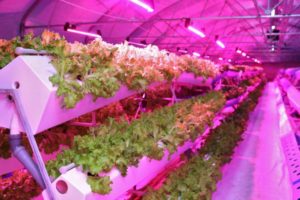
If you are just starting in the field of hydroponics, the concept of growing plants indoors in soil-free media or simply with a nutrient mist probably sounds far-fetched and complex to you. But hydroponics is a rapidly evolving technology that many vertical farms worldwide use to cultivate crops such as leafy greens, tomatoes, and strawberries.
Hydroponics is an indoor farming method in which plants are grown in mediums composed of inert, organic substances such as coconut coir, rock wool, or clay pellets instead of soil. The roots of the plants are continuously supplied with water and nutrients through an elaborate system of pipes.
This article will explore in detail what hydroponics is, the main elements of a hydroponic setup, as well as, some of the advantages and disadvantages associated with this type of system.
How does hydroponic work in vertical farming?
Hydroponics and recirculating hydroponics in particular have become popular growing methods in vertical farming. But what are hydroponics systems and how do they work?
Typically, hydroponic systems have two main components: a reservoir that contains the water-nutrient solution and a growing tray that holds the plants. Crops are planted in pots filled with organic materials, such as perlite, coconut coir, Rockwool, Growstones, or expanded clay pellets, which provide physical support to the root system. Nutrients such as nitrogen, potassium, phosphorus, calcium, iron, manganese, zinc, and chlorine are dissolved in water and delivered directly to the roots. Plants are normally suspended in the air, above the water reservoir, with their roots either partially or fully submerged in it.
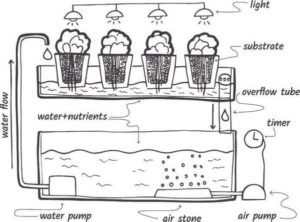
Components of hydroponic setup
Growing media
In hydroponic systems, the growing media is used to stabilize the plants, as well as act as a buffer. They must possess specific characteristics in order to allow plants to grow healthy. An ideal growing medium should maintain an equal air-to-water ratio, a medium level of cation exchange capability to preserve nutrients and be organic and biodegradable. The most effective and commonly used media include Rockwool, expanded clay pellets, coconut fiber, Growstones, and oasis cubes.
Here is a look at some of the most common types of growing mediums used in hydroponics and their specific properties.
Rockwool
This non-degradable, porous medium is made of granite and limestone rocks, which are heated until they melt and then spun into fine long fibers. Its great water-holding capacity and aerating properties make it particularly useful in hydroponics. Its only downside is its high natural pH, which can alter the pH levels of the nutrient solution.
Oasis Cubes
A non-reactive nutrient solution characterized by a neutral pH, good aeration, and a large water-holding capacity. These cubes are made from floral foam that resembles a sheet. It is primarily used as a starting environment for seedlings, and it is rarely used as a growing media. One disadvantage of oasis cubes is that they crumble easily and are not reusable.
Coconut Fibers
Made from the brown husk of coconuts, this growing media is highly inert and has good water holding capacity. It can be used either alone or mixed with other growth media like expanded clay pellets, and it is entirely organic.
Growstones
A high-quality growing media made of 99% recycled glass, Growstone is lightweight, highly porous, and provides excellent air circulation. It is used alone or in combination with other substrates, such as coconut fiber. The downsides of this medium include its dustiness, ability to adhere to roots of some plants, and high cost.
Expanded Clay Pellets
Expended clay pellets are small, porous, and lightweight balls characterized by a neutral pH and capable of providing strong support to plants. They can be reused after being cleaned and sterilized. They have a very low water holding capacity because of the large spaces between the pellets, so they are not ideal for ebb-and-flow systems.
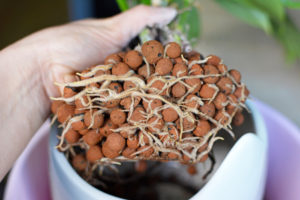
Fertilizers
In traditional farming, fertilizers are typically added to the soil to eliminate nutrient deficiencies, but in hydroponics systems, they must provide all the necessary nutrients for the plants to grow. Ideally, a hydroponic fertilizer would contain all the essential nutrients and trace elements required by the plants, including microelements, secondary nutrients, and microelements. The types of fertilizers used in hydroponics can be organic or inorganic.
Inorganic fertilizers
Inorganic fertilizers are substances composed of minerals and synthetic chemicals, usually processed from natural resource materials. Calcium nitrate (CaNO3), for example, is used in hydroponic systems to supply plants with essential microelements such as calcium and nitrogen. For inorganic fertilizers to benefit plants and avoid plant damages and death, they must be accurately dosed, easily absorbed by the plants, and easily measured by conductivity testing.
Organic fertilizers
Typically, organic fertilizers are made of plant or animal-derived materials or by-products of natural processes. For hydroponics, organic fertilizers are trickier to supply than inorganic ones as they have to be partially decomposed before the plants can absorb them. Additionally, the nutrient solution needs to be changed frequently to avoid odor formation. Organic fertilizers are suitable only for a few hydroponic systems.

The Farmstand Is Your Self-Watering, Self-Fertilizing Solution for an Easy to Grow Harvest
Air Pumps
Plants require oxygen to survive, and in some hydroponics systems, they can “drown” if not provided with enough oxygen. Plants cultivated in deep-water culture (DWC) systems can suffocate if not supplied with the right amount of oxygen since their roots are submerged in the nutrient reservoir all the time. The oxygenation process in most hydroponics systems consists of three main components: air pumps, air stones, and airline tubing.
Air pumps are usually placed outside the water-nutrient reservoir, moving air from the room and pushing it to an air stone device located at the bottom of the reservoir. The air stone and the air pump are connected by airline tubing. Tiny oxygen bubbles are produced in the reservoir when air is forced through the air stone, oxygenating the water. If you don’t wish to set up and maintain an oxygenation system, hydroponics techniques, such as ebb and flow, NFT, or aeroponics, do not require one.
Water
Hydroponic systems are dependent on water as it is the medium in which the nutrients are dissolved and transported to the plants. Supplying hydroponic systems with clean and high-quality water is essential in maintaining a balanced environment and growing healthy plants. The quality of the water in hydroponic systems can affect plant growth in a variety of ways, such as causing stunted growth and mineral toxicity.
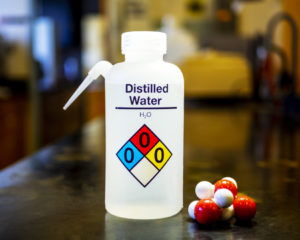
Water containing high concentrations of chlorine, chloramines, and bacteria is unsuitable for hydroponic systems since it stunts the growth of leafy greens like lettuce. Many hydroponic systems use distilled water, which is void of solid particles and elements. Water purified by reverse osmosis is also a great option but not a necessity.
Pipes
Pipes are an integral part of hydroponics systems since they link the nutrient reservoir to the growing trays where the plants are situated. They allow water and nutrients to flow from the reservoir to the growing tray and back. Hydroponics systems mostly employ PVC pipes, which are available in round and rectangular shapes and various lengths. Moreover, PVC pipes are usually white and do not retain heat. Currently, PVC pipes are widely used for the cultivation of various crops, including lettuce, tomato, and cucumber.
Types of hydroponics systems
A total of six types of hydroponic systems are currently in use worldwide: Basic Wick, Deep-Water Culture (DWC), Ebb and Flow, Drip Hydroponics Systems, NFT Hydroponics Systems, and Aeroponics Systems. Hydroponic systems based on the types of equipment they use are divided into passive or active systems. Active hydroponic systems such as NFT use moving parts like air pumps to push water from the reservoir into the growing tray. Passive hydroponics employs wicks and capillary systems to deliver water and nutrients to the roots.
If you came here for the information, please keep reading, because this post is chalk full of great information. But if you are like me, and just really kinda want to get started at home, then I can recommend this complete kit so you can start growing at home. Keep in mind that this is a beginner kit, but it will get you fresh veggies and is well worth the investment. But the kit is worth nothing without the seeds, so don’t forget them, and start growing some fresh food in your kitchen! You will be having fresh salad in just a few weeks! Goodbye store bought greens!
Basic Wick
The Basic Wick is undoubtedly one of the easiest systems to install and operate as it does not require equipment like pumps and motors. It relies solely on the capillary action of water to transfer nutrient solutions from the reservoir into the growing medium. For those new to hydroponics and especially for those with little experience, Wick systems are ideal. However, this passive system also has its drawbacks since toxic nutrient buildup occurs in the growing media, and, only a limited number of crops can be grown successfully. Generally, this type of system is used to cultivate leafy greens, like lettuce and spinach.
Ebb and flow systems
In contrast to the other hydroponic systems we have discussed until now, ebb and flow systems have two main phases: flooding and draining. The flood phase involves flowing water and nutrients over the roots of the plants to feed them, and during the draining phase, the water is drawn back to the reservoir, allowing the root system to drain and absorb oxygen. The plants are placed in a growing tray which is attached to the reservoir via a drain fitting. A programmable timer controls the submersible fountain pump, thus controlling the water pumping cycles as well. Once the timer goes off, the water pump starts pumping water and nutrients up into the growing tray allowing the roots to soak up water. Gravity then pulls the solution back into the reservoir after reaching the water level.
Ebb and flow systems are generally low-maintenance and cost-effective as they reuse any excess nutrients. Typically, they are used to grow leafy greens such as lettuce and herbs but can also be adjusted to grow plants of all sizes. Despite this, this system is vulnerable to power outages, and it requires experience to make the appropriate adjustments to the flooding and draining cycles.
Drip Hydroponic Systems
Drip hydroponic systems are widely used by both commercial and small growers due to their efficiency to cultivate large plants that require a lot of root space. Through drip irrigation, nutrients and water are delivered directly to the plant roots, therefore allowing growers to control the amount of water and nutrients they supply to their plants. In a drip hydroponics system, submersible pumps continually pump the water and nutrient solution from the reservoir up through the drip pipes and to the roots of plants. This system is fully automated, and it works with various types of media, including clay pellets, gravel, coconut coir, and Rockwool. Besides leafy greens and herbs, drip hydroponic systems can grow larger plants like strawberries, tomatoes, cucumbers, and onions.
Deep Water Culture (DWC)
Deep-water culture is one of the simplest and most cost-effective active systems of hydroponics today. DWC is usually used to grow leafy greens such as lettuce and herbs, and it is one of the most commonly used hydroponic systems along with the nutrient film approach. Plants cultivated in the DWC system are suspended in pots above the reservoir, allowing their roots to be submerged directly into the nutrient solution via floating Styrofoam. Air pumps are used to supply oxygen to the roots. If not supplied with oxygen roots can develop root rot.
Here is an example of one of these systems, if you are interested in getting started at home!
NFT Hydroponic Systems
The Nutrient Film Technique is a popular hydroponic system used in vertical farming by small-scale farms and commercial ones alike. It is an active recirculating system where the water is pumped from the water-nutrient reservoir into the channel system and to the plant’s roots. The growing tray in NFT systems is elevated on one side, with a slope of approximately 0.3-2%. The water-nutrient solution is continuously pumped from the reservoir to the elevated side of the tray, soaking the roots. The excess solution is drained back to the reservoir via connecting tubes.
The NFT systems are particularly popular in vertical farming due to their efficiency in reducing water and nutrient consumption. However, NFT systems aren’t suitable for cultivating large plants, limiting growers only to leafy greens. They are also susceptible to power and pump failures that, if not addressed quickly, can lead to plant death.
If you are interested in starting one of these systems, check out this set up here. Or if you don’t want to commit to something like that, we can recommend this one!
Aeroponics Systems
It is the most advanced form of hydroponics because it uses little to no water and does not require solid materials, like Rockwool or coconut coir. In an aeroponics system, plants’ roots are suspended in the air and sprayed directly with nutrient-containing droplets. Aeroponics systems typically consist of a reservoir, net cups, timer, water pump, and misting nozzles. The reservoir is home to the water-nutrient solution, as well as the water pump, which transfers the water into the misting nozzles via the piping system. Pumping from the reservoir is controlled by a programmable timer. Plants are inserted into net cups that contain holes that allow the root system to grow normally.
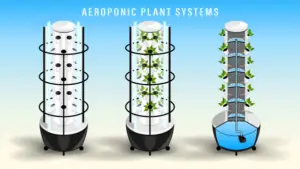
Aeroponics systems can be used to grow a wide range of crops including strawberries, leafy greens, root crops, tomatoes. However, aeroponics is a relatively new technology that requires highly trained workers to set it up, and it is also more expensive to maintain than other hydroponic systems. It also depends heavily on technology, which can result in catastrophic losses for growers in the event of a malfunction.
Advantages and disadvantages of hydroponics systems
Advantages
Reduced water consumption
Hydroponics systems use about ten times less water than traditional farming methods. For instance, in the Nutrient Film Technique (NFT), water and nutrients are captured and recirculated back to the plant, thereby reducing water usage and eliminating agricultural runoff as well. Gotham Greens, an urban farm that uses recirculating hydroponics, has managed to significantly reduce its water consumption by 95%. Moreover, a study conducted by NASA found that aeroponics systems reduce water usage by as much as 98 percent.
Take up less space
Traditional farming emphasizes spacing so that the root systems can fully develop, thus increasing the demand for land. With hydroponics, extensive root growth is not necessary as water and nutrients are provided directly to them. Consequently, plants can be planted closely together, maximizing yield even in areas with limited space.
Minimized use of fertilizers and pesticides
In vertical farming, pest invasions do not pose a threat as plants are grown indoors, allowing vertical farms to omit pesticide applications. Hydroponically grown plants receive the exact amount of fertilizers required for optimal growth directly to their roots, thus eliminating agriculture runoff. Moreover, a NASA study reported that aeroponics reduces fertilizer usage by up to 60%.
Higher yields
In hydroponics systems, growers can fully control the growing conditions of their crops, thereby vertically grown plants are not exposed to abiotic stresses such as pH imbalances, water shortages, and lack of nutrients. Additionally, hydroponics eliminates soil-borne disease-related yield loss as well. According to a University of Mississippi study, basil, chard, red kale, parsley, bell peppers, cherry tomatoes, and cucumber recorded higher yields when grown aeroponically than when grown in soil. Among the above-mentioned plants, red kale exhibited the highest yield with an average increase of about 65%.
If you are interested in getting started in Hydroponics, check out this beginner system here and start growing your own clean crops today!
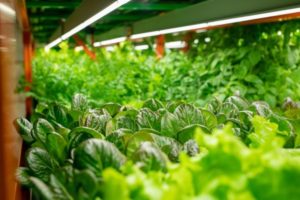
Different types of hydroponics techniques
As mentioned above, at present there are six main types of hydroponics techniques that can be tailored to work in any vertical farm. This allows vertical farmers to choose the most appropriate system for their project depending on their needs and knowledge.
Disadvantages
Upfront costs are high
Hydroponic systems are expensive and complex to set up as they require various types of equipment, such as air pumps, air stones, reservoirs, growing trays, pipes, and air tubes. Additionally, choosing the appropriate equipment that fulfills the needs of their project can pose an additional challenge to many inexperienced vertical farmers.
They must consider many important parameters such as the size of the pumps, the number of nozzles, their durability, how noisy it is, and how much it will cost.
High maintenance costs
Hydroponics systems must be monitored and controlled regularly to detect and avoid devastating problems. For instance, the reservoir and the pipes should be cleaned frequently to avoid clogging, salt buildup, and bacterial growth. Additionally, other technical parameters such as water temperature, pH levels, nutrient content, and water composition must be monitored regularly to ensure the hydroponics system is properly working.
Dependent on power outages
Hydroponic systems use electrical devices such as timers, air pumps, and water pumps, and unexpected events such as power blackouts can result in substantial losses if not resolved immediately by the growers.
Prior knowledge is required
Growers need to understand the exact amount of nutrients and water their plants need, as even a tiny miscalculation mistake could result in stunted growth or plant death. Hydroponic systems rely on nutrient solutions to provide plants with all the necessary elements for their growth, making them more vulnerable to human errors. Moreover, newer systems like aeroponics are more complex to set up and operate and often require specialized workers.
